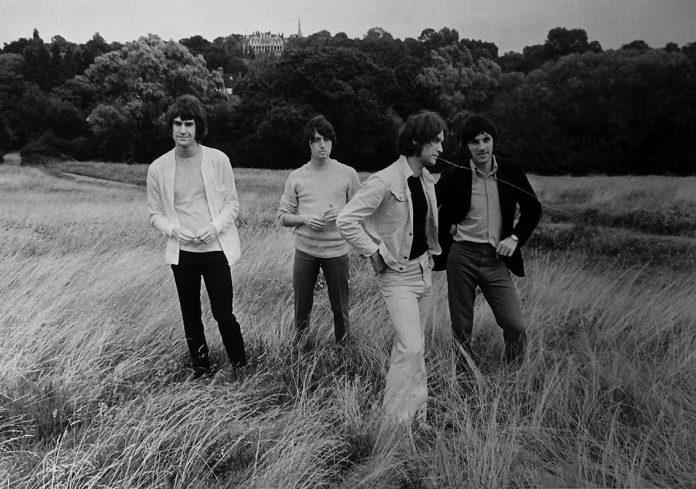
Film.
A scene from the film, above, and the real Harry Hallowes below.
Hampstead, 2017
Starring Diane Keaton and Brendan Gleeson, Hampstead loosely tells the story of Harry Hallowes, ‘Harry the Hermit’, who was a homeless man who lived in a shack on Hampstead Heath for over 20 years until his death in 2016.
Harry set up camp on the Heath near Athlone House after he was evicted from his Highgate council flat in 1987, and won a legal battle for ownership of his plot (worth over £2 million) in 2007 through squatters’ rights, after developers tried to kick him out of his home.
BELLE, 2014
Belle tells the extraordinary true story of Dido Elizabeth Belle, who lived at Kenwood House with her great aunt and uncle, the 1st Mansfields, for 31 years in the late 1700s. Dido was born into slavery - she was the illegitimate daughter of the Mansfield’s nephew Sir John Lindsay and an enslaved African woman in the West Indies. She was brought to Kenwood by her father and raised as an educated gentlewoman alongside her cousin Elizabeth, at a time of extreme racism when the slave trade was at its height. Not much is known of her life, or what happened to her mother, but her family was incredibly fond of her and her influence is thought to have played a part in key legal decisions that helped to bring about the abolition of slavery. Her great uncle, the 1st Earl of Mansfield, was Lord Chief Justice at the time and ruled in 1772 that slavery had no precedent in English common law and had never been authorised under positive law. He also ruled against slave owners in the landmark Zong massacre case.
Kenwood House was undergoing restoration work when the film was released, so unfortunately the film was not shot here. Instead, the West Wycombe Park in Buckinghamshire stood in for Kenwood in exterior shots, and interiors were filmed at Chiswick House and other west London locations. Still, this is arguably the most heartening and mysterious story of Kenwood’s history.
elsewhere on screen
The 2006 film Scenes of a Sexual Nature, which actually contains no scenes of a sexual nature, was shot entirely on Hampstead Heath. Starring Ewan McGregor, Sophie Okonedo, Hugh Bonneville, Catherine Tate, Andrew Lincoln, Tom Hardy and others, it follows seven couples as they talk love, sex and politics on a sunny summer afternoon.
The Heath also features in Notting Hill, mostly around Kenwood House where Julia Robert’s character was filming a movie, and the 1950s films Dangerous Youth and The Noble Art filmed scenes on the Heath.

Poetry.
John Keats moved with his brothers to 1 Well Walk in Hampstead in 1817. The house was close to the homes of other romantic poets in his circle, notably Leigh Hunt and Samuel Taylor Coleridge. John and George were nursing their brother Tom, who died later that year of tuberculosis. John’s famous poem Ode to a Nightingale was inspired by a bird he heard while at the Spaniards Inn, and written in his garden at what is now Keats House. In a letter to his brother George in April 1818, Keats wrote that he and Coleridge had a long walk together on the Heath and talked about "a thousand things,... nightingales, poetry, poetical sensation, metaphysics." John sadly also died of tuberculosis in 1821, aged just 25.
“My heart aches, and a drowsy numbness pains
My sense, as though of hemlock I had drunk,
Or emptied some dull opiate to the drains
One minute past, and Lethe-wards had sunk:
‘Tis not through envy of thy happy lot,
But being too happy in thine happiness–
That thou, light-wingèd Dryad of the trees,
In some melodious plot
Of beechen green, and shadows numberless,
Singest of summer in full-throated ease.
O, for a draught of vintage! that hath been
Cooled a long age in the deep-delved earth,
Tasting of Flora and the country green,
Dance, and Provençal song, and sunburnt mirth!
O for a beaker full of the warm South,
Full of the true, the blushful Hippocrene,
With beaded bubbles winking at the brim,
And purple-stained mouth;
That I might drink, and leave the world unseen,
And with thee fade away into the forest dim:
Fade far away, dissolve, and quite forget
What thou among the leaves hast never known,
The weariness, the fever, and the fret
Here, where men sit and hear each other groan;
Where palsy shakes a few, sad, last gray hairs,
Where youth grows pale, and spectre-thin, and dies;
Where but to think is to be full of sorrow
And leaden-eyed despairs;
Where Beauty cannot keep her lustrous eyes,
Or new Love pine at them beyond tomorrow.
Away! away! for I will fly to thee,
Not charioted by Bacchus and his pards,
But on the viewless wings of Poesy,
Though the dull brain perplexes and retards:
Already with thee! tender is the night,
And haply the Queen-Moon is on her throne,
Clustered around by all her starry Fays;
But here there is no light,
Save what from heaven is with the breezes blown
Through verdurous glooms and winding mossy ways.
I cannot see what flowers are at my feet,
Nor what soft incense hangs upon the boughs,
But, in embalmèd darkness, guess each sweet
Wherewith the seasonable month endows
The grass, the thicket, and the fruit-tree wild;
White hawthorn, and the pastoral eglantine;
Fast fading violets covered up in leaves;
And mid-May’s eldest child,
The coming musk-rose, full of dewy wine,
The murmurous haunt of flies on summer eves.
Darkling I listen; and, for many a time
I have been half in love with easeful Death,
Called him soft names in many a musèd rhyme,
To take into the air my quiet breath;
Now more than ever seems it rich to die,
To cease upon the midnight with no pain,
While thou art pouring forth thy soul abroad
In such an ecstasy!
Still wouldst thou sing, and I have ears in vain–
To thy high requiem become a sod.
Thou wast not born for death, immortal bird!
No hungry generations tread thee down;
The voice I hear this passing night was heard
In ancient days by emperor and clown:
Perhaps the self-same song that found a path
Through the sad heart of Ruth, when, sick for home,
She stood in tears amid the alien corn;
The same that oft-times hath
Charmed magic casements, opening on the foam
Of perilous seas, in fairy lands forlorn.
Forlorn! the very word is like a bell
To toll me back from thee to my sole self!
Adieu! The fancy cannot cheat so well
As she is famed to do, deceiving elf.
Adieu! adieu! thy plaintive anthem fades
Past the near meadows, over the still stream,
Up the hill-side; and now ’tis buried deep
In the next valley-glades:
Was it a vision, or a waking dream?
Fled is that music: – Do I wake or sleep?”
The poet Leigh Hunt wrote the first of his five sonnets, To Hampstead, invoking the Heath’s ‘sweet upland’ while in prison in August 1813. After his release, he settled at the Vale of Health in 1816 for five years. Shelley, Keats and Byron were among his visitors.
“They tell me, when my tongue grows warm on thee,
Dear gentle hill, with tresses green and bright,
That thou art wanting in the finishing sight
Sweetest of all for summer eye to see;—
That whatsoe’er thy charm of spire and tree,
Of dell wrapped in, or airy-viewing height,
No water looks from out thy face with light,
Or waits upon thy walks refreshfully.
It may be so,—casual though pond or brook:—
Yet not to me so full of all that ‘s fair,
Though fruit-embowered, with fingering sun between,
Were the divinest fount in Fancy’s nook,
In which the Nymphs sit tying up their hair,
Their white backs glistening through the myrtles green.”
The prominent Victorian women’s rights campaigner, poet and writer Bessie Rayner Parkes wrote a very long poem called London from Hampstead Heath, and Wordsworth wrote a very short one of the same name. The acclaimed poet and playwright Joanna Baillie lived for several decades at Bolton House in Hampstead with her sister, where she counted Wordsworth, Keats and Byron as friends.
Later, the novelist, playwright and poet James Elroy Flecker also wrote several poems referencing Hampstead Heath. James’s death in 1915 at the age of thirty was described at the time as "unquestionably the greatest premature loss that English literature has suffered since the death of Keats".
“From Heaven’s Gate to Hampstead Heath
Young Bacchus and his crew
Came tumbling down, and o’er the town
Their bursting trumpets blew.
The silver night was wildly bright,
And madly shone the Moon
To hear a song so clear and strong,
With such a lovely tune.
From London’s houses, huts and flats,
Came busmen, snobs, and Earls,
And ugly men in bowler hats
With charming little girls.
Sir Moses came with the eyes of flame,
Judd, who is like a bloater,
The brave Lord Mayor in coach and pair,
King Edward, in his motor.
Far in a rosy mist withdrawn
The God and all his crew,
Silensus pulled y nymphs, a faun,
A satyr drenched in dew,
Smiled as they wept those shining tears
Only immortals know,
Whose feet are set among the stars,
Above the shifting snow.
And one spake out into the night,
Before they left for ever,
“Rejoice, rejoice!” and his great voice
Rolled like a splendid river.
He spake in Greek, which Britons speak
Seldom, and circumspectly;
But Mr. Judd, that man of mud,
Translated it correctly.
And when they heard that happy word,
Policemen leapt and ambled:
The busmen pranced, the maidens danced,
The men in bowlers gambolled.
A wistful Echo stayed behind
To join the mortal dances,
Bur Mr Judd, with words unkind,
Rejected her advances.
And passing down through London Town
She stopped, for all was lonely,
Attracted by a big brass plate
Inscribed, FOR MEMBERS ONLY.
And so she went to Parliament,
But those ungainly men
Woke up from sleep, and turned about,
And fell asleep again.”
“Our haughty life is crowned with darkness,
Like London with its own black wreath,
On which with thee, O Crabbe! forth-looking,
I gazed from Hampstead’s breezy heath.”
“I walked with Maisie long years back
The streets of Camden Town,
I splendid in my suit of black,
And she divine in brown.
Hers was a proud and noble face,
A secret heart, and eyes
Like water in a lonely place
Beneath unclouded skies.
A bed, a chest, a faded mat,
And broken chairs a few,
Were all we had to grace our flat
In Hazel Avenue.
But I could walk to Hampstead Heath,
And crown her head with daisies,
And watch the streaming world beneath,
And men with other Maisies.
When I was ill and she was pale
And empty stood our store,
She left the latchkey on its nail,
And saw me nevermore.
Perhaps she cast herself away
Lest both of us should drown:
Perhaps she feared to die, as they
Who die in Camden Town.
What came of her? The bitter nights
Destroy the rose and lily,
And souls are lost among the lights
Of painted Picadilly.
What came of her? The river flows
So deep and wide and stilly,
And waits to catch the fallen rose
And clasp the broken lily.
I dream she dwells in London still
And breathes the evening air,
And often walk to Primrose Hill,
And hope to meet her there.
Once more together we will live,
For I will find her yet:
I have so little to forgive;
So much, I can’t forget.”
“Down by the pond
In Hampstead Heath
Two lovers in wellington boots
They come down here most Sundays
To see the ducks the swans and the coots”

Art.
The Heath is as popular with the painters as it is with the poets. Most famously, John Constable spent his final ten years here, until is death 1837. Other artists who lived and painted in the area include Thomas Gainsborough and George Romney (both portrait painters, so no Hampstead Heath), Robert Finlay McIntyre, John Linnell, Ernest Stamp, Charles Ginner, Patrick Lewis Forbes and more recently, Gillian Lawson. Wyldes Farm, then known as Collins Farm, was home to John Linnell for four years from 1824 and Charles Ginner lived for several years at 61 Hampstead High Street until 1938.
Literature.
In Bram Stoker’s Dracula, Lucy Westenra lived and was buried in Hampstead. When Professor Abraham van Helsing and Dr John Stewart visit Lucy’s tomb they visit The Spaniards Inn and Jack Straw’s Castle, and Lucy abducts children playing on the Heath when she rises. The opening scenes of Wilkie Collins’ 1859 The Woman In White are set on Hampstead Heath - this is where Walter Hartright first encounters a strange woman, dressed all in white - though the Heath scenes in the recent film adaptation were filmed instead in Ireland. More recently, Hampstead Heath is a primary location in Will Self’s 2006 novel The Book of Dave, and Zadie Smith wrote about the Heath in NW and On Beauty.
“A sprawling North London parkland, composed of oaks, willows and chestnuts, yews and sycamores, the beech and the birch; that encompasses the city’s highest point and spreads far beyond it; that is so well planted it feels unplanned; that is not the country but is no more a garden than Yellowstone; that has a shade of green for every possible felicitation of light; that paints itself in russets and ambers in autumn, canary-yellow in the splashy spring; with tickling bush grass to hide teenage lovers and joint smokers, broad oaks for brave men to kiss against, mown meadows for summer ball games, hills for kites, ponds for hippies, an icy lido for old men with strong constitutions, mean llamas for mean children and, for the tourists, a country house, its façade painted white enough for any Hollywood close-up, complete with a tea room, although anything you buy there should be eaten outside with the grass beneath your toes, sitting under the magnolia tree, letting the white blossoms, blush-pink at their tips, fall all around you. Hampstead Heath! Glory of London! Where Keats walked and Jarman fucked, where Orwell exercised his weakened lungs and Constable never failed to find something holy.”
Many authors have also lived by the Heath over the years, and countless more have been regular visitors. Famously, a distraught Charles Dickens escaped to Wyldes Farm for five weeks in 1837 following the unexpected death of his sister-in-law Mary Hogarth. He was writing the Pickwick Papers and Oliver Twist at the time, both of which were being published as monthly serials and had hectic deadlines. Dickens is thought to have known North End well since his childhood, having visited with his father when he was trying to evade creditors, and visited the Heath and pubs like Jack Straw’s Castle and the Spaniards regularly throughout his life.
In 1934-1935, George Orwell (or Eric Blair, as he was born) worked afternoons in the Booklovers’ Corner bookshop on the corner where Pond Street and South End Road meet - now a cafe. He lived in a flat above the bookshop, and later at what was then a dingy flat at 77 Parliament Hill. This was just after Down and Out in Paris and London had been published, and he was writing his third novel Keep the Aspidistra Flying while he lived here. His work in the bookshop was the inspiration for his essay Bookshop Memories. After Hampstead, he didn’t move far - his next stop was 50 Lawford Road, Kentish Town. It’s also said that CS Lewis was inspired to write the novel The Lion, the Witch and the Wardrobe while walking on the Heath on a snowy day.

The Kinks, 1968
Photoshoot on the Heath for The Village Preservation Society.
Photos by Barrie Wentzell.




















